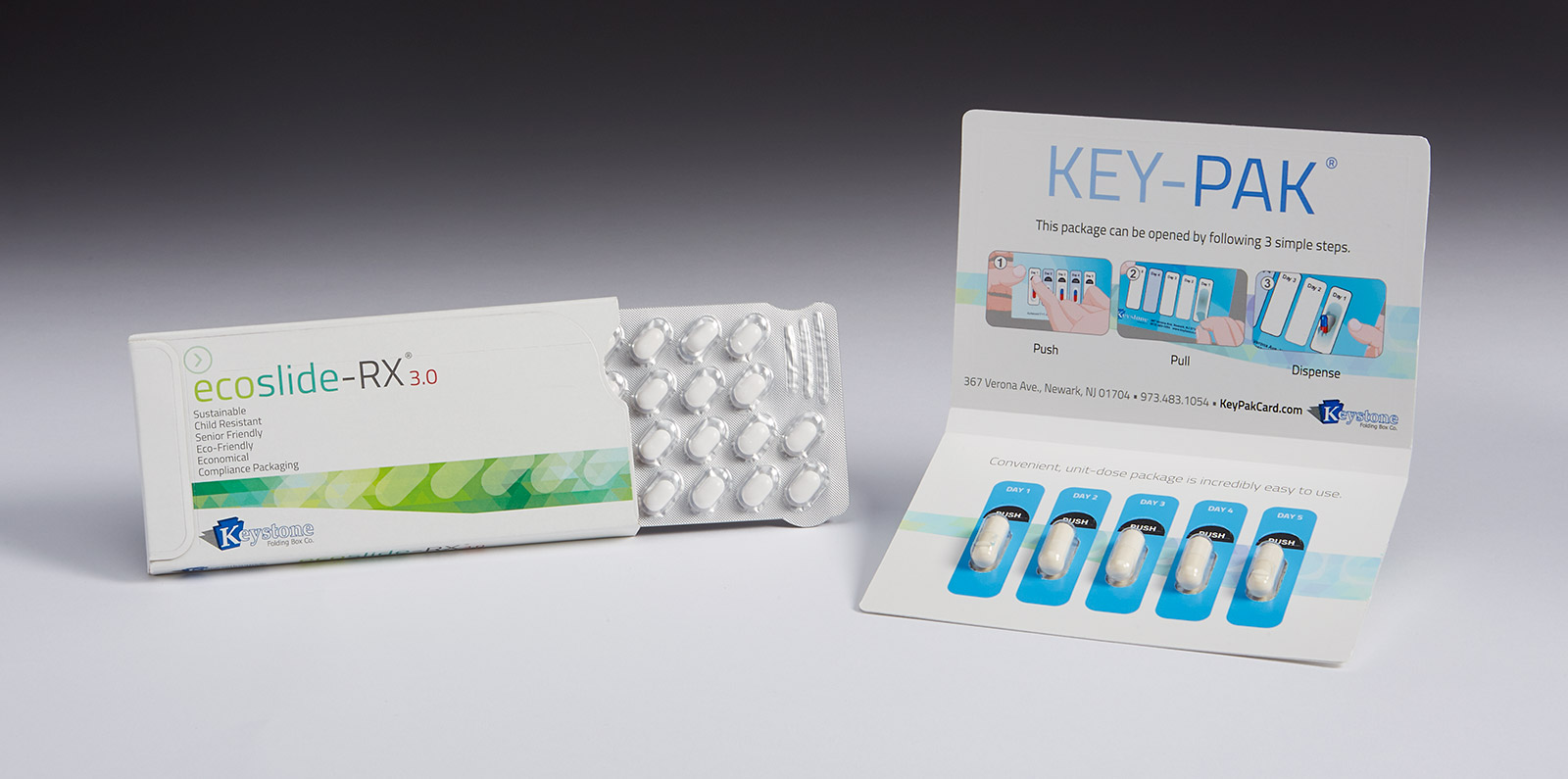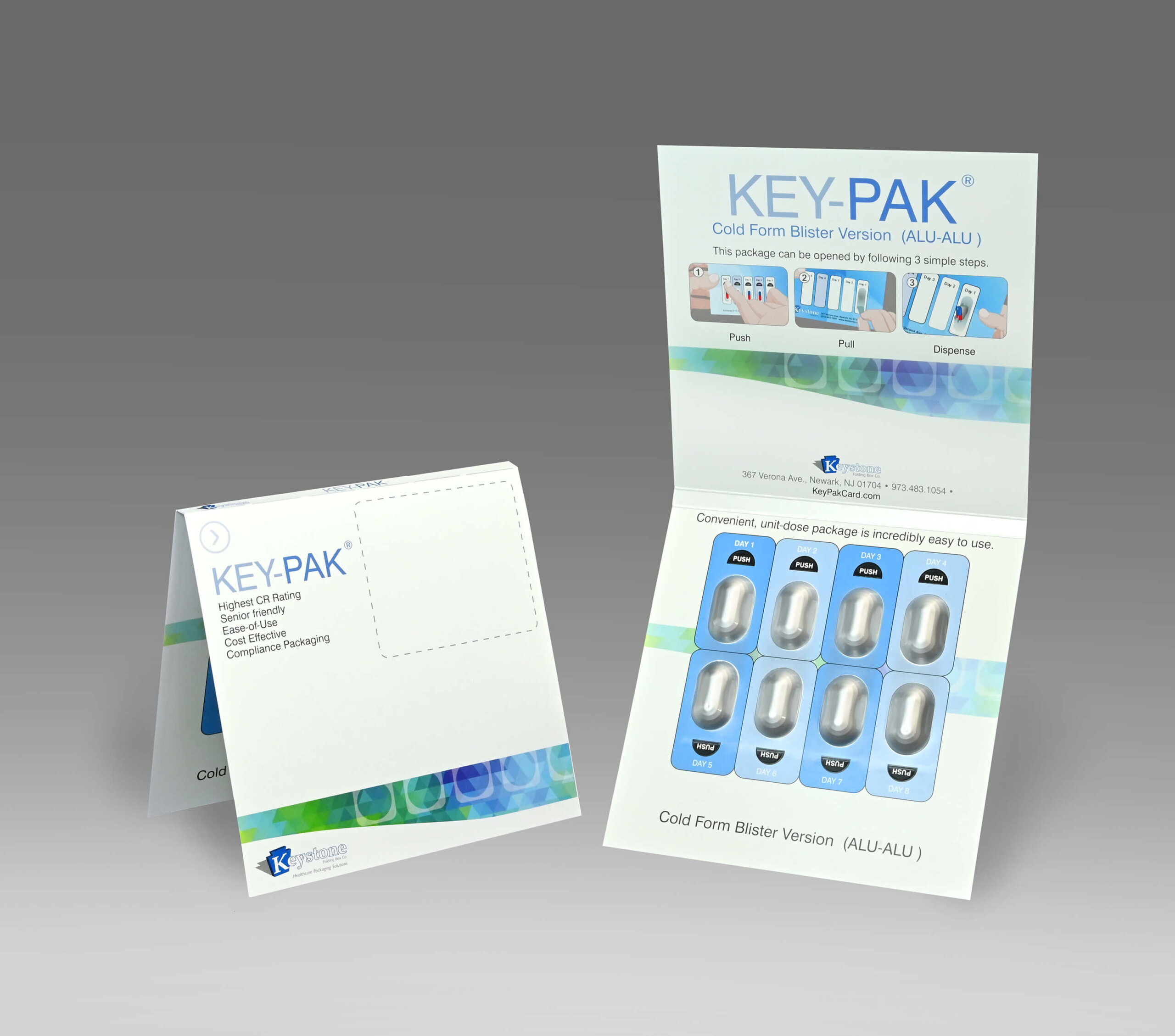Compliance Packaging
Compliance Packaging
While the U.S. consumer is familiar seeing medication in both bottles and blisters, bottles have become a dominate package format in the U.S. Alternatively, since the end of World War II the European standard for packaging medication has shifted towards the use of blister packs. In fact, 80% of medications dispensed in Europe are now in blisters. In evaluating blister vs. bottles, blisters offer multiple benefits to the manufacturer, pharmacy staff, and patients. Areas of benefit include: Child Safety, Product Quality, Medication Adherence & Patient Outcomes, and Environmental Responsibility.
Both child safety and medication compliance (or adherence) are among the most important factors to consider for packages containing over-the-counter or prescription pharmaceutical products.
Child Safety
In terms of safety, studies have consistently shown that blister packaging outperforms child-resistant (CR) bottles. On March 15, 2018, CBS News reported on a study citing “Blisters are 65% more effective in preventing child access to medication.” The report further states that kids can open child-resistant pill bottles in seconds, risking accidental poisoning. In a test the group set up at a Maryland daycare center, children ranging in ages 3 to 5 managed to pop open child-resistant pill bottles in mere seconds.
In 2015, child poisoning from access to medications was reported in 8,972 cases in the United States. The number of accidental poisoning is actually down since the last report in 2010 – thanks, in part, to a growing use of blister packages. When caps are inadvertently left partially closed or off the bottles the CR feature becomes irrelevant and leaves all pills exposed to a child. In contrast, blister packs can provide a significantly higher level of safety for children. Some blister solutions can provide a Child-Resistant safety lever of F=1, the highest child-resistance rating available.
Compliance/Adherence
Published studies have shown a direct connection between calendarized blister packaging and improved patient compliance/adherence to dosing regimens. While medication adherence is a complex issue, calendarized blister packs directly counteract patient forgetfulness by providing a visual dose history for each day of the week.
-
- Improved Adherence: Unit-of-use blistered medications are easier to use, particularly for patients taking multiple pills per dose and those who have difficulty remembering proper dosage protocols. By adding printed dosing instructions on the pack near each dose, the packaging becomes a dose prompting “reminder package,” directly impacting insight into dosing history. Beyond the interaction with physicians and pharmacy staff, the package is something the patient interacts with on a daily basis, making it a repetitive communication device with the patient on proper dosing. The oral contraceptive market is an example of how “compliance packaging” works. Not a single birth control pill is sold any other packaging format. Conversely, a bottle offers no benefit in the area of improving adherence.
-
- More accurate dispensing: Pre-packaged medication in blister packs reduces the chance for dispensing errors within pharmacy operations. Blister packaged medications allow prescriptions to be filled faster as no pill counting and repackaging by the pharmacy staff is required, eliminating pill count errors. If a mistake has been made by a pharmacy staff member when pulling a drug from the shelf, both the name of the drug and the strength of the medication remain visible to the patient, allowing the patient an opportunity to verify they have received the correct product. On the other hand, when prescriptions are dispensed in amber vials, the patient has nothing on which to rely other than the pharmacy label and the hope that they have received the correct medication.
-
- Improved refill rates: Blister packages make it easier for patients to manage their own supply of products. With bottles, many patients don’t realize they need to refill their prescription until they are down to the last one or two pills which can lead to missed doses until such a time the patients can get the prescription refilled. Calendarized blister cards can be printed with “time to refill” near the last five doses in the package, which prompts the patient to call in for a prescription refill.
Product Quality
Every medication package, both bottle and blister, must go through stability testing to ensure an adequate barrier of protection is intact. The goal is to protect the medication from moisture and/or oxygen either of which could have a negative impact on the product’s chemical assay and reduce the efficacy of the medication.
With a blister package, each individual pill cavity protects the dose inside until you remove a pill from the package. This ensures optimal quality of the product until a patient removes each dose.
Bottles can be deceiving in the area of product quality. When a manufacturer packages product in a 500-count bottle, for example, there is stability data that allows that product to have the necessary barrier protection until the initial opening of the bottle. Once the cap is removed to fill the first prescription and the induction seal is broken, the barrier is never the same. Each time the bottle is opened to fill yet another prescription, the ambient air and humidity of the room is introduced to the remaining product inside. Of course, product sent home with a patient that are packaged in a traditional amber vial also compound the problem of barrier protection.
The result of a 2015 study published by the Healthcare Compliance Packaging Council (HCPC) points to degradation risks associated with plastic bottles. The study supports the concerns about exposure to moisture and oxygen and the impact to medication even under normal usage conditions. The results also showcase how the composition of tablet packaging can determine the medication’s likelihood of degrading. Specifically, polypropylene vials, high-density polyethylene (HDPE) bottles and polyvinyl chloride (PVC) blisters, all of which are found in traditional retail and institutional pharmacy settings, may increase tablets’ risk for higher physical degradation when compared to high-barrier single-dose packages such as PVC/Aclar or PVC/polyvinylidene chloride (PVdC) blisters.
The study concludes that U.S. patients taking medications from non-barrier packaging may not get the intended clinical benefit of the drug due to potential product degradation from daily exposure to the home environment. The HCPC sees the next step as broadening the scope of research to include chemical assay tests on drugs exposed to these or similar study conditions, with a goal of determining potential efficacy impact.
Walt Berghahn, HCPC Executive Director, states the following: “Packages need to protect pharmaceutical products during their entire life cycle. As shown in this study, single-dose packages using high-barrier materials can accomplish that goal so long as the temperature profile is maintained. Once we move closer to protecting these products appropriately, we help ensure that patients receive effective products.” The full HCPC Prescription Packaging-In-Use Stability Study can be found at: www.hcpconline.org
Environmental Impact
According to a 2017 article in National Geographic, “A Whopping 91% of Plastic Isn’t Recycled.” This includes a significant amount of medication packaging made from plastic resin. Many organizations have adopted sustainability initiatives in an effort to minimize their impact on the environment. Reducing the use of non-renewable resources is a common goal of most initiatives. Both blister packages and bottles are produced from plastic resin, and non-renewable resource. However, blister packages contain only a fraction of the amount of plastic material required to produce a bottle and cap. At a glance, it might seem that since blisters are recyclable they are less sustainable than bottles. After all, bottles tend to have and debossed triangle on the bottom with a number inside, which is commonly perceived and a recycling demarcation.
The problem with recycling plastic medicine bottles is that most curbside programs do not accept them. According to the Association of Plastic Recyclers (APR), “Items smaller than 2 inches in 2 dimensions render the package non-recyclable.” (Polypropylene and HDPE bottles) Local recycling centers use automated screeners to separate items suitable for recycling from items that go into landfill. APR states “the industry standard screen size loses materials less than three inches to a non-plastics stream… or directly to [landfill] waste.” U.S. landfills are being filled with a sea of orange vials from prescription bottles, and if half of those prescriptions were dispensed in a blister package there would be a significant reduction of plastic making its way into landfills across the country. Blister packs offer drug manufacturers and retailers a more sustainable solution for dispensing prescription products.
Where do we go from here?
While many organizations may feel they are limited to the use of bottles due to their current infrastructure of bottling lines, there are many contract packaging organizations are well equipped to take on the task of packaging or repackaging medication in blister packaging. These contract packagers can allow for a rapid change in packaging format. Often, the only regulatory requirement is filing a CBE 30 form with the FDA allowing your package to be converted to blisters in a relatively short timeframe. Retailers can purchase the drug in bulk from manufacturers or wholesalers and have contract packagers manage the process of packaging into unit-of-use packages; in this case, the only requirement would be compliance with the state board of pharmacy guidelines.
With about 80% of U.S. pharmaceutical products today being delivered and dispensed in bottles, there is a huge opportunity to utilize more blisters and have a meaningful impact on: the environment, product quality, child safety and patient outcomes through improved adherence.



